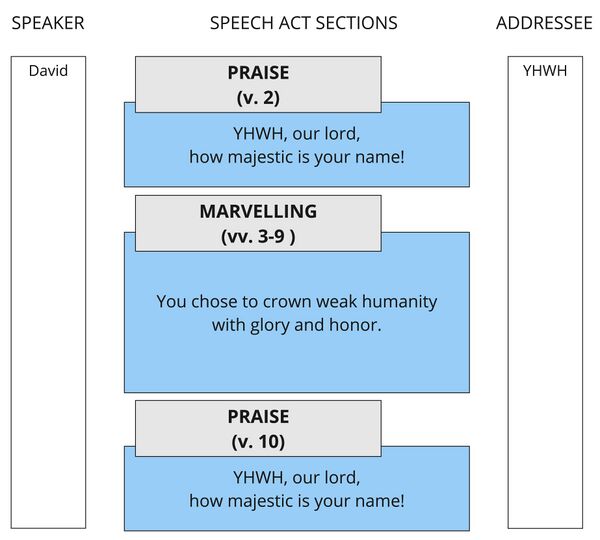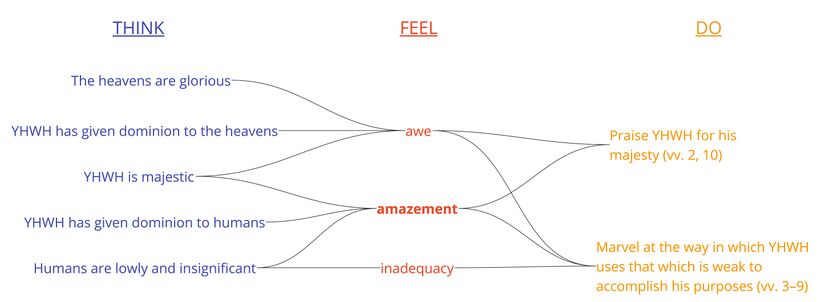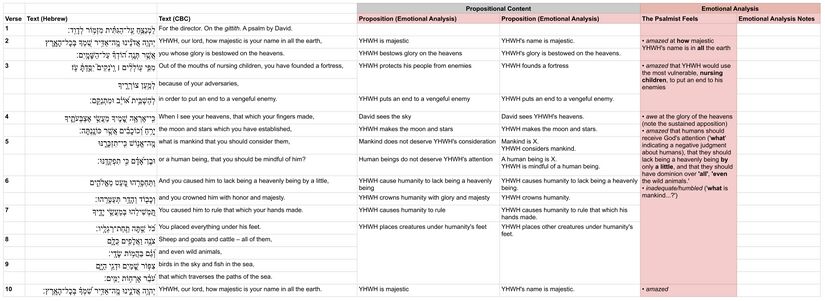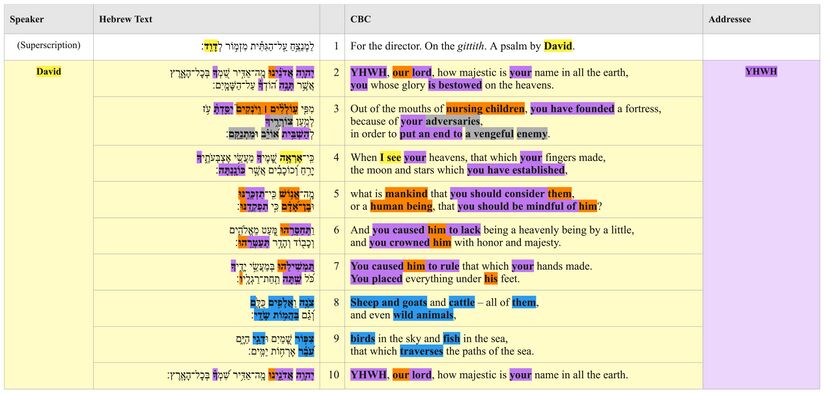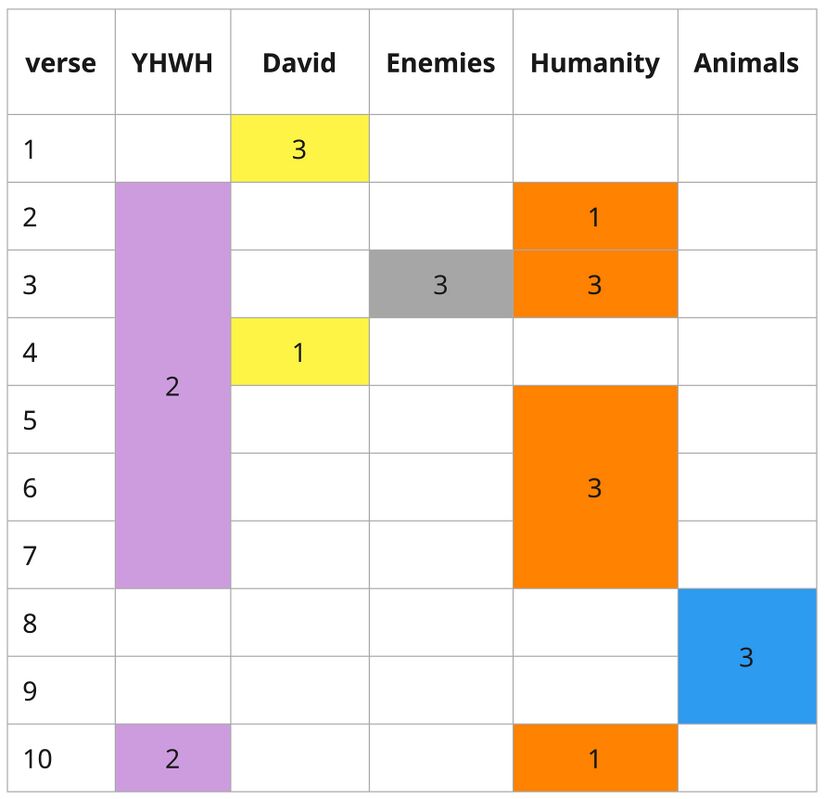Psalm 8 Discourse
Back to Psalm 8
About the Discourse Layer
Our Discourse layer includes four analyses: macrosyntax, speech act analysis, emotional analysis, and participant analysis. (For more information, click 'Expand' to the right.)
Macrosyntax
The macrosyntax layer rests on the belief that human communicators desire their addressees to receive a coherent picture of their message and will cooperatively provide clues to lead the addressee into a correct understanding. So, in the case of macrosyntax of the Psalms, the psalmist has explicitly left syntactic clues for the reader regarding the discourse structure of the entire psalm. Here we aim to account for the function of these elements, including the identification of conjunctions which either coordinate or subordinate entire clauses (as the analysis of coordinated individual phrases is carried out at the phrase-level semantics layer), vocatives, other discourse markers, direct speech, and clausal word order.
For a detailed explanation of our method, see the Macrosyntax Creator Guidelines.
Speech Act Analysis
The Speech Act layer presents the text in terms of what it does, following the findings of Speech Act Theory. It builds on the recognition that there is more to communication than the exchange of propositions. Speech act analysis is particularly important when communicating cross-culturally, and lack of understanding can lead to serious misunderstandings, since the ways languages and cultures perform speech acts varies widely.
For a detailed explanation of our method, see the Speech Act Analysis Creator Guidelines.
Emotional Analysis
This layer explores the emotional dimension of the biblical text and seeks to uncover the clues within the text itself that are part of the communicative intent of its author. The goal of this analysis is to chart the basic emotional tone and/or progression of the psalm.
For a detailed explanation of our method, see the Emotional Analysis Creator Guidelines.
Participant Analysis
Participant Analysis focuses on the characters in the psalm and asks, “Who are the main participants (or characters) in this psalm, and what are they saying or doing? It is often helpful for understanding literary structure, speaker identification, etc.
For a detailed explanation of our method, see the Participant Analysis Creator Guidelines.
Discourse Visuals for Psalm 8
Macrosyntax
Notes
Paragraph Divisions
- v. 1: Superscription
- vv. 2-3. The use of a vocative marks this unit.
- vv. 4-5 are bound together as a syntactic unit. Verse 4 is the protasis, verse 5 the apodosis. The temporal כִּי in v. 4 begins a new paragraph.
- vv. 6-9. The distribution of second person verb forms in vv. 6-7 (wayyiqtol, yiqtol, yiqtol, qatal) binds these clauses together as a unit. Vv. 8-9 are in apposition to כֹּל (v. 7b) and are thus part of the same macrosyntactic unit.
- v. 10. The cessation of appositional phrases and the use of a vocative marks a new macrosyntactic unit.
Word Order
- vv. 2, 10. The unmarked word order of verbless clauses is Subject-Predicate.[1] The use of interrogative>exclamatory מה and the consequent fronting of the predicate adjective (אַדִּיר) means that the predicate is probably marked.[2] The particle ma "functions as an introduction to an exclamation in which a speaker usually expresses a value judgment about something."[3]
- v. 3a. The PP מִפִּ֤י עֽוֹלְלִ֨ים ׀ וְֽיֹנְקִים֮ is fronted for marked focus (Lunn 2006:296 – "MKD"). YHWH has founded a fortress not by means of the powerful and eloquent, but by means of the feeble cries of the weakest and most vulnerable. "לְמַעַן is a subordinating conjunction that is also used secondarily as a preposition" (BHRG 40.36). In this clause, where is governs only a NP, it functions as a preposition (see grammatical diagram). "The clause or noun phrase with לְמַעַן typically follows the matrix clause" (BHRG 40.36).
- v. 4a. Despite the agreement among the ancient translators that the כִּי in v. 4 is causal (LXX [οτι], Symmachus [γαρ], Peshitta [ܡܛܠ], Targum [מטול], Jerome [enim]), there is virtual unanimity among modern translations and commentators that כי here introduces a temporal clause: "When I see... [then I think/exclaim] what is mankind...?"[4]
- v. 5. On מה followed by כי followed by yiqtol, cf. 1 Sam 18:18. "A result clause can be introduced by כי, notably after a question."[5]
- v. 6a. On the wayyiqtol see notes on verbal semantics.
- v. 7b. The direct object "everything" (כֹּל) is fronted for marked focus.[6] YHWH has subjected everything to humanity's rule; no creature has been excluded. On the significance of this word in the psalm, see repeated roots.
- vv. 8-9. For the numerous and complex appositional relationships in this verse, see the grammatical diagram.
Speech Act Analysis
Summary Visual
Speech Act Chart
Emotional Analysis
Summary visual
Emotional Analysis Chart
Participant analysis
There are five participants/characters in Psalm 8:
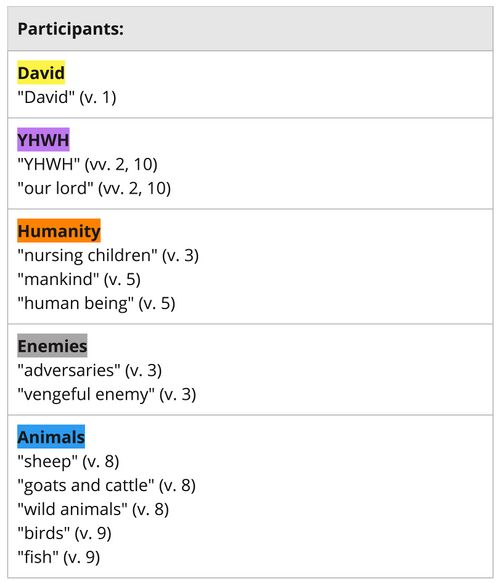
- David: David, the 10th century king of Israel and Judah, is named in the superscription (v. 1) as the author of the psalm. The fact that the psalm was written by a king is significant. Behind the psalm's reflection on humanity, there is an implicit reflection on David's kingdom and dynasty. David, the shepherd boy and the youngest of his brothers, was an unlikely candidate for the throne (cf. v. 5). Nevertheless, YHWH exalted him and gave him dominion over his enemies (cf. vv. 6–9).
- YHWH: The psalm is addressed to "YHWH" (vv. 2, 10), the God of Israel and the creator and "Lord" of the world. The entire psalm is addressed to YHWH in the second person. "It is worth stressing that throughout the entire poem, the Creator is addressed directly and intimately: your name, you have established, your heavens, you remember them, and so on."[7]
- Nursing children: (עוֹלְלִים וְיֹנְקִים) (v. 3) represent the weakest and most vulnerable part of the human race (cf. 1 Sam 15:3; 22:29; Jer 44:7; Lam 1:16; Joel 2:16). They are an image of Israel and her kings, who were completely dependent on YHWH for help. Their best hope was to cry out to him.
- YHWH's enemies (v. 3) may be either "historical persons and nations (Ps 2:1-3) or mythological beings and disruptive cosmic forces (Pss 74:13; 89:10; 93:3)."[8] Those who argue for the latter think that "the enemy and avenger in v. [3]c are best explained as a reference to the foes that God overcomes in the process of creation."</ref>Jacobson 2014, 123.</ref> Those who argue that the adversaries are human and historical point to the use of the phrase "your adversaries" (צֹרְרֶיךָ) in Ps 74:4 and "vengeful enemy" (אויב ומתנקם) in Ps 44:17 to refer to Israel's enemies[9] along with the fact that "here, as throughout the psalms, the psalmist is fluidly able to identify personal enemies with those hostile to God."[10] This view is probably correct, and the enemies probably refer to the enemies of God's people.
- Animals: Vv. 8-9 lists three basic categories of animals: (1) land animals, domestic and wild (v. 8), (2) birds (v. 9aα), and (3) fish (v. 9aβb). The list of animals in these verses illustrate the "horizontal vector that moves outward from human society: sheep and oxen → beasts of the field → birds → fish → whatever passes the paths of the seas."[11] There is a subtle connection between the "enemies" whom YHWH defeats (v. 3) and the "animals" which YHWH subjugates under humanity's feet (vv. 8–9). Elsewhere, wild animals are used to depict the enemies of God's people (e.g., Pss 7:3; 10:9; 17:12; 22:13, 17, 22; 68:30; 80:14,[12] and the image of being put "under one's feet" evokes the conquest of enemies (cf. Josh 10:24; Ps 110:1). The point of the connection is not to say that animals are somehow morally on par with YHWH's wicked enemies. It is to say, however, that they represent a force of chaos that must be subdued.
Participant Relations Diagram
The relationships among the participants may be abstracted and summarized as follows:
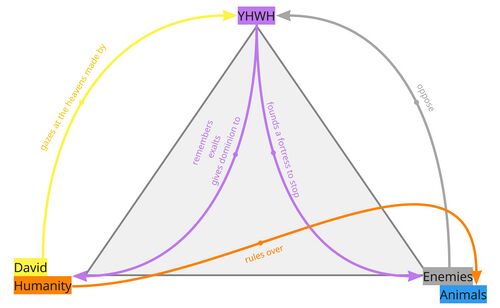
Participant Analysis Table
Participant Analysis Summary Distribution
Bibliography
- Baethgen, Friedrich. 1904. Die Psalmen. Göttingen: Vandenhoeck und Ruprecht.
- Brown, William. 2002. Seeing the Psalms: A Theology of Metaphor. Louisville: Westminster John Knox Press.
- Jacobson, R. A. 2014. "Psalm 8," in N. DeClaissé-Walford, R. A. Jacobson & B. L. Tanner (eds.) The Book of Psalms. Grand Rapids, MI: Eerdmans.
- Lunn, Nicholas P. 2006. Word-Order Variation in Biblical Hebrew Poetry: Differentiating Pragmatics and Poetics. Paternoster Biblical Monographs. Milton Keynes: Paternoster.
- Rogerson, J. W., and J. W. McKay. 1977. Psalms. Vol. 1. The Cambridge Bible Commentary on the New English Bible. Cambridge: Cambridge University Press.
- Whitekettle, Richard. 2006. “Taming the Shrew, Shrike, and Shrimp: The Form and Function of Zoological Classification in Psalm 8.” JBL 125: pp. 749-65.
- Wilson, Gerald H. 2002. The NIV Application Commentary: Psalms. Vol. 1. Grand Rapids: Zondervan.
Footnotes
- ↑ BHRG 46.2.3.1.
- ↑ Cf. Ps 36:8.
- ↑ BHRG 42.3.6, citing Ps 8:2/10 as an example.
- ↑ Cf. GKC 159dd; IBHS 38.7a.
- ↑ IBHS 38.3b.
- ↑ So Lunn 2006, 296 – "MKD".
- ↑ Jacobson 2014, 123.
- ↑ Rogerson and McKay 1977, 42.
- ↑ E.g., Baethgen 1904, 21.
- ↑ Wilson 2002, 203; cf. Ps 2:3; 1 Sam 30:26.
- ↑ Jacobson 2014, 125; cf. Whitekettle 2006, 757-761.
- ↑ Cf. Brown 2002, 137-144.

